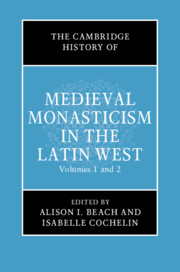Book contents
- The Cambridge History of Medieval Monasticism in the Latin WEST
- The New Cambridge History of Medieval Monasticism in the Latin West
- The Cambridge History of Medieval Monasticism in the Latin WEST
- Copyright page
- Contents
- Figures
- Contributors
- Acknowledgments
- Abbreviations
- 1 General Introduction
- Part I The Origins of Christian Monasticism to the Eighth Century
- Part II The Carolingians to the Eleventh Century
- 18 The Historiography of Central Medieval Western Monasticism
- 19 Sources for the History of Monasticism in the Central Middle Ages (c. 800–1100)
- 20 Questions of Monastic Identity in Medieval Southern Italy and Sicily (c. 500–1200)
- 21 Discerning “Reform” in Monastic Liturgy (c. 750–1050)
- 22 Monasticism, Reform, and Authority in the Carolingian Era
- 23 Carolingian Monastic Schools and Reform
- 24 Monastic Economics in the Carolingian Age
- 25 Missions on the Northern and Eastern Frontiers, c. 700–1100
- 26 Minsters and Monasticism in Anglo-Saxon England
- 27 Monastic Art and Architecture, c. 700–1100: Material and Immaterial Worlds
- 28 Monastic Daily Life (c. 750–1100): A Tight Community Shielded by an Outer Court
- 29 The Double Monastery as a Historiographical Problem (Fourth to Twelfth Century)
- 30 Interactions between Monks and the Lay Nobility (from the Carolingian Era through the Eleventh Century)
- 31 Monastic Reform from the Tenth to the Early Twelfth Century
- 32 Monastic Canon Law in the Tenth, Eleventh, and Twelfth Centuries
- 33 Eastern Influence on Western Monasticism, 850–1050
- Part III The Long Twelfth Century
- Part IV Forms of Monasticism in the Late Middle Ages
- Index
- References
21 - Discerning “Reform” in Monastic Liturgy (c. 750–1050)
from Part II - The Carolingians to the Eleventh Century
Published online by Cambridge University Press: 16 January 2020
- The Cambridge History of Medieval Monasticism in the Latin WEST
- The New Cambridge History of Medieval Monasticism in the Latin West
- The Cambridge History of Medieval Monasticism in the Latin WEST
- Copyright page
- Contents
- Figures
- Contributors
- Acknowledgments
- Abbreviations
- 1 General Introduction
- Part I The Origins of Christian Monasticism to the Eighth Century
- Part II The Carolingians to the Eleventh Century
- 18 The Historiography of Central Medieval Western Monasticism
- 19 Sources for the History of Monasticism in the Central Middle Ages (c. 800–1100)
- 20 Questions of Monastic Identity in Medieval Southern Italy and Sicily (c. 500–1200)
- 21 Discerning “Reform” in Monastic Liturgy (c. 750–1050)
- 22 Monasticism, Reform, and Authority in the Carolingian Era
- 23 Carolingian Monastic Schools and Reform
- 24 Monastic Economics in the Carolingian Age
- 25 Missions on the Northern and Eastern Frontiers, c. 700–1100
- 26 Minsters and Monasticism in Anglo-Saxon England
- 27 Monastic Art and Architecture, c. 700–1100: Material and Immaterial Worlds
- 28 Monastic Daily Life (c. 750–1100): A Tight Community Shielded by an Outer Court
- 29 The Double Monastery as a Historiographical Problem (Fourth to Twelfth Century)
- 30 Interactions between Monks and the Lay Nobility (from the Carolingian Era through the Eleventh Century)
- 31 Monastic Reform from the Tenth to the Early Twelfth Century
- 32 Monastic Canon Law in the Tenth, Eleventh, and Twelfth Centuries
- 33 Eastern Influence on Western Monasticism, 850–1050
- Part III The Long Twelfth Century
- Part IV Forms of Monasticism in the Late Middle Ages
- Index
- References
Summary
In his Colloquy, Ælfric of Eynsham (d. c. 1010) has the boys of his monastery pretend to be laborers, tradesmen, and professionals so that they may learn the Latin vocabulary for the characteristic tasks and implements of each kind of work. The ploughman tends his oxen, the hunter his hounds and nets. The monk’s occupation is the liturgy, the “work of God” (opus Dei, RB 43.3), before which nothing is to be preferred
- Type
- Chapter
- Information
- The Cambridge History of Medieval Monasticism in the Latin West , pp. 415 - 431Publisher: Cambridge University PressPrint publication year: 2020
References
- 1
- Cited by



